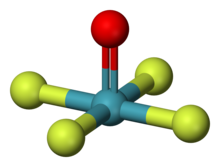Xenon oxytetrafluoride

| |

| |
| Identifiers | |
|---|---|
3D model (
JSmol ) |
|
| ChemSpider | |
| |
| |
| Properties | |
| XeOF4 | |
| Molar mass | 223.23 g/mol |
| Appearance | colorless liquid |
| Density | 3.17 g/cm3, liquid |
| Melting point | −46.2 °C (−51.2 °F; 227.0 K) |
| Reacts with water | |
| Structure | |
Except where otherwise noted, data are given for materials in their standard state (at 25 °C [77 °F], 100 kPa).
| |
Xenon oxytetrafluoride (
A high-yield synthesis proceeds by the reaction of XeF
6 with POF
3 at −196 °C (−320.8 °F; 77.1 K).[6]
Like most xenon oxides, it is extremely reactive, and it hydrolyses in water to give hazardous and corrosive products, including hydrogen fluoride:
- 2 XeOF
4 + 4O
2
In addition, some ozone and fluorine is formed.
Reactions
XeOF
4 reacts with H
2O in the following steps:
The XeO
3 formed is a dangerous explosive, decomposing explosively to Xe and O
2:
- 2 XeO
3 → 2 Xe + 3 O
2
In its liquid form, XeOF
4 exhibits amphoteric behaviour, forming complexes with both strong Lewis bases like CsF and strong Lewis acids like SbF
5.[7] It forms a 1:1 adduct with XeF
2, isostructural with XeF
2·IF
5,[8] as well as various heavy alkali metal fluorides.[4]
The reaction of XeOF
4 with XeO
3 provides a convenient synthesis route for XeO
2F
2.[9]
External links
- Xenon tetrafluoride oxide in Linstrom, Peter J.; Mallard, William G. (eds.); NIST Chemistry WebBook, NIST Standard Reference Database Number 69, National Institute of Standards and Technology, Gaithersburg (MD) (retrieved 2022-04-13)
